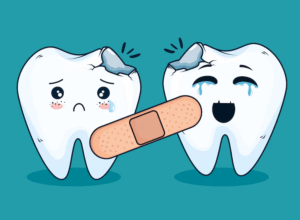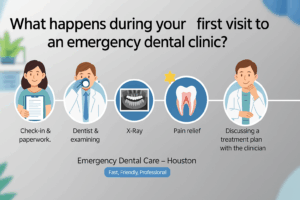Periodontal disease, which is usually referred to as gingival (gum) disease, is the inflammation of the gingival tissue that subsequently destroys the gingiva, jawbones, and other supporting tissues and structures around the teeth. Periodontal disease is an inflammatory disease of the mouth and typically occurs as either gingivitis (gum inflammation) or periodontitis (gum disease). Periodontal disease is one of the leading causes of tooth loss in adults.
Both gingivitis and periodontitis are different periodontal disease stages and should not be confused for each another. Gingivitis, being the early stages of periodontal disease, normally precedes periodontitis. However, if periodontal disease treatment is administered early, gingivitis may not progress to periodontitis.
For example, gingivitis is characterised by bacteria build up in the plaque or food chunks, which causes the gingiva to become inflamed. This makes the gum to bleed during tooth brushing. Gingivitis mostly causes gum irritation, the teeth are unaffected and still firmly placed in the jawbone. At this stage, no irreversible damage is done yet to the bone or other tissues.
However, when gingivitis is left untreated, it advances to periodontitis. At the periodontitis stage, damages are done to the gum and other dental tissues. Both the inner layer of the gingivae and jawbone pull away from the teeth to form pockets. Pockets are small spaces between the teeth and gingivae that collect debris and can soon be infected by bacteria. As the plaque grows and spreads below the gum line, the body immune system fights the bacteria infection.
The bacteria in the plaques produce poisons and toxins and the body immune system produces “good” enzymes to fight off the bacterial infection. The actions of both the toxins/poisons and “good” enzymes break down the jawbone and other supporting tissues that hold the teeth in place.
As the periodontal disease progresses, it causes the pockets to deepen and the bacterial infection increases. This causes more gingival tissue and jawbone to be destroyed. Subsequently, the teeth become weak and loose as they are no longer firmly held in place. After some times, tooth loss occurs.
The accumulation of plaque, which is the main cause of gum disease, is as a result of poor dental care practices. However, other factors are also responsible for the disease, such as genetics, tobacco chewing and smoking, medications, certain medical illnesses, etc.
What Are The Symptoms of Periodontal Disease?
Sometimes, periodontal disease may progress painlessly and produce only a few obvious symptoms. This means that you may not notice any sign or symptom, yet you may still be suffering from a certain degree of periodontal disease. In some other cases, the periodontal disease may only affect certain tooth or set of teeth like the molars.
Only a professional dentist would be able to recognize and determine the progress of periodontal disease. This is a big reason why you need to visit your dentist for a regular dental check-up. Notwithstanding how subtle the signs and symptoms of periodontal disease may be, there are some warning signs and symptoms of periodontal disease that one should be aware of. These include:
- Bleeding gums during and after tooth brushing
- Tenderness, redness, or swelling of the gums
- Receding gums
- Persistent bad breath or bad taste in the mouth
- Formation of pockets between the teeth and gums
- Loose, weak, or shifting teeth
- Noticeable changes in the way the teeth fit together when biting or chewing.
What Are the Different Stages of Periodontal Disease?
Like stated above, there are two main stages of periodontal disease. If immediate periodontal disease treatment is given in the first stage, the disease can be reversed and any loss of a tooth can be prevented. Generally, to prevent periodontal disease, it is important to observe good and proper oral hygiene practices as well as schedule a dental visit for dental cleanings and check-ups at least twice a year.
If your dentist detects any sign or symptom of periodontal disease during the dental check-up, he or she would be able to commence immediate periodontal disease treatment on you to eliminate the disease and instruct you on the necessary steps to take as regards proper and improved at-home dental care.
Stage 1: Gingivitis
This is the early stages of periodontal disease and is mostly caused by bacterial build-up. Gingivitis affects only the soft tissue of the gingivae and inflammation is noticed around the gums with the appearance of swelling and redness. Bleeding gums during and after during tooth brushing and irritating gums are also indications of the presence of gingivitis. In order to prevent the development of the gingival disease, it is necessary to remove the plaque build-ups.
Affected patients may not experience any pain and discomfort at this stage. In fact, the sign and symptoms may be subtle or very mild and include:
- Bleeding or swollen gingivae
- Metallic taste or bad breath in the mouth
- Irritating gum
- Receding gums (longer teeth)
- Widening gaps between teeth
It is very important to diagnose the periodontal disease at this early stage before it advances to the next stage – periodontitis.
Stage 2: Periodontitis
This is the advanced stages of periodontal disease. It usually occurs as a result of negligence or late periodontal disease treatment.
At this stage of gum disease, not only the gingivae are affected but also the jawbone and other supporting structures of the teeth are affected as well.
Early Periodontitis
Lack of periodontal disease treatment will cause the gingivitis to advance. As the gingivae become more inflamed, they pull away from the teeth to form pockets. The pockets begin to collect food chunks, plaques, and bacteria, which lead to bacterial infection. The bacteria release toxins and the body immune system responds to the bacterial infection. These actions cause damage to the surrounding jawbone.
Moderate Periodontitis
As the gum inflammation spreads, the damaging effect of periodontitis become more severe, and some pain and discomfort may be experienced. At this stage, more jawbone and supporting structure is lost, the gingivae recede further, and the teeth loosen.
Advanced Periodontitis
Advanced periodontitis is the final stages of periodontal disease and the leading causes of tooth loss in adults. At this stage, the bacterial infection has spread fully beneath the gingivae and is usually characterised by painful abscesses.
What Is The Treatment For Periodontal Disease?
Gingivitis can be easily treated and reversed by following good and proper oral care practices and avoiding unhealthy lifestyles and practices. However, early periodontitis may be treated with “deep cleaning.” This periodontal disease treatment involves scaling, root planing and curettage.
- Scaling is a treatment to remove the tartar above the gum line.
- Root planing is the deep cleaning of the root surfaces to eliminate dental plaque, chunks, and bacteria inside the periodontal pocket.
- Curettage is the scraping/removal of diseased soft tissue on the root surface. It involves removing any dead, damaged, or infected tissue from the teeth.
The essence of scaling, root planing and curettage is to eliminate pocket. Most cases of periodontal disease respond to this treatment. However, in more advanced periodontitis, surgical procedures may be required.
Do you have more related questions or want to learn more about periodontal disease, contact us today.





